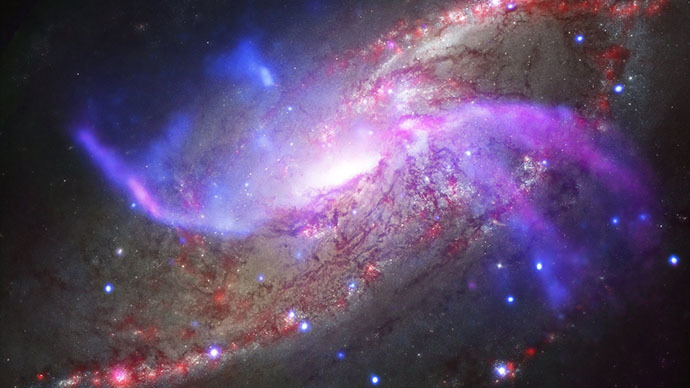It’s December and among other things, this means it is time for me to order a new calendar. This is one of the easiest things in my life because I always order the same calendar each year. This year’s Space calendar from the Smithsonian featured images from the Chandra X-Ray telescope. This particular calendar features Chandra images composited with the other orbiting satellites, Hubble and Spitzer, as well as from the Very Large Array down here on the ground with us.
For some people, it’s standing at the edge of the Grand Canyon for the first time. Or it’s in a canoe on a fantastically still lake. Perhaps for you it’s diving a reef or watching a beetle crawl over a leaf. Whatever it is that touches off that spark of awe and wonder, which drives home that sense you’re a part of something vast, ancient, and ineffable, whatever that thing is for you, highly detailed images of our universe does that for me.
But in a sense, it’s important to remember that these pictures are not real. The sense I’m talking about is sight. Let me explain. The final month of this calendar (which sits directly above and behind my laptop, less than a foot away) reads:
“NGC 4258 is a spiral galaxy well known to astronomers for having two so called anomalous arms that glow in X-ray, optical, and radio light. Rather than being aligned with the plane of the galaxy, they intersect with it. This composite image of NGC 4258 shows the galaxy in X-rays from Chandra (blue), radio waves from the Very Large Array (purple), optical data from Hubble (yellow and blue), and infrared with Spitzer (red). Researchers are using all of these telescopes to better understand how the supermassive black hole is affecting the galaxy and its anomalous arms.”
In a way, I see these images as works of art. No more “real” than Van Gogh’s “Starry Night.” Both images are works of human creativity, understanding, and passion. They are not representations of nature as we see them with our naked eye. Which is to say, the magnificent galaxy I see hovering in mid swirl over the edge of my laptop screen would not look anything like this if I were viewing it out of the window from my luxury suite onboard the good ship Hey look, We figured it out. What Van Gogh saw that starry night was most certainly there, but no human other than him saw it that way. The galaxy I have on my wall is most certainly there – an image created by many who all view it as no single human physically can.
Pictures of galaxies and gaseous pillars and nebulae, these things are just small parts of even larger structures we can now apprehend. Views no other humans previous to us were privy. Their sheer immensity is one of the things which overwhelms me. The amount of matter and energy they represent is staggering, and still only a fraction of what must be there in order for our universe to make sense with how we currently understand it. The knowing of this and where I place in both scale and importance… I can think of few things as awe inspiring as that. We are both utterly insignificant and more precious than anything else I can think of. We are hydrogen that has organized itself in such a fashion as to recognize and appreciate that fact.
Seeing a different stunning image of what lies beyond the everyday experiences of human beings each month soothes me on a number of different levels. I experience a certain amount of pride for being part of a civilization which is daily uncovering truths and explaining the nature of our reality in a way our ancestors could quite literally not imagine. It places the uncomfortable vagaries of my life in their proper place. Of all the times and places I could be an organized collection of transmuted hydrogen capable of awe and wonder, now is the time I find myself, at the edge of the already wondrous.
And things are just starting to get interesting.
These thoughts also help me to remain positive in a culture that has only just recently made concern, alarm, and downright fear a part of our everyday life. Someone somewhere is telling a group of humans that another group of humans wants them suffering and or dead. The terrifying part is a good portion of what is presented as fearful is worthy of that reaction. Our conversion of natural resources into pollution is a danger to most of the complicated life on the planet. Our political processes and institutions are seemingly hamstrung by an extremely small part of the global population for reasons that primarily benefit them, to the detriment of more than just their fellow human beings. Rationality and a respect for the truth are under increasing disdain for a number of reasons, as keeping people ignorant and misinformed is useful for more than just financial gain.
But like the composite image of NGC 4258 this is only one particular view of the world around us. Yes, those things are certainly there but they are presented to be viewed in a certain light, a composite image formed by many, presented to many, designed to foster a view according to its own set of values, its own priorities of hues and framing. Both NGC 4258 and “Starry Night” offer valuable ways of seeing the night time sky, neither of them do so faithful to the human eye. Wisdom requires seeing both for what they are, noting their differences, and appreciating that reality is big enough to accommodate both. Unless you think the Earth is flat, no older than 6000 years, and will soon end in fire and death. How can one accommodate an outlook such as that?
It’s December and time to order next year’s calendar. I’ll have twelve new images of our universe that Aristotle could never dream of. I’ll see things that Kepler would have given his left testicle for. I’ll gaze upon vistas in such detail, they would have caused Michelangelo to weep. This gives me hope that the future, not just my future, short as that will be in the cosmic scale of things, but the future of us as collections of organized hydrogen capable of recognizing and appreciating that fact, will continue to improve, continue to keep us on the edge of the already wondrous.
With things just starting to get interesting.

